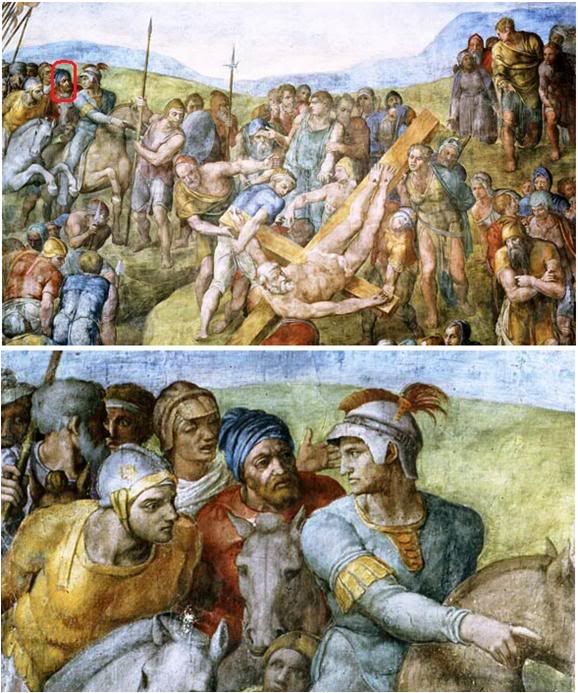 Only in Rome, and only in the context of Christian tradition, can a number of history-making major cultural markers come in such awesome succession as we have 'witnessed' in the past few days.
Only in Rome, and only in the context of Christian tradition, can a number of history-making major cultural markers come in such awesome succession as we have 'witnessed' in the past few days.
First, the discovery of those 4th-century portraits of Peter and Paul in a Roman catacomb; then the news that the Vatican had sampled the interior of St. Paul's sarcophagus and received unbiased Carbon-14 dating that supports the unbroken traditional belief that the apostle was iindeed buried there; and then the unveiling of Michelangelo's last great frescoes after decades of virtual oblivion in a Vatican chapel that has now been restored.
Now, there's another historical twist to the last:
Michelangelo's self-portrait
seen in his fresco painting
of Peter's crucifixion
by Richard Owen in Rome

July 2, 2009
The restoration of frescoes by Michelangelo in the Vatican has revealed what is believed to be a self-portrait of the artist.
The face is in a wall mural in the Vatican’s Pauline Chapel or Cappella Paolina, according to Maurizio De Luca, the Vatican’s chief restorer. The chapel, which is used by the Pope and not open to the public, was unveiled this week after a restoration costing €3.2 million (£2.7 million).

Professor De Luca said that a figure on horseback in a blue turban in Michelangelo’s The Crucifixion of St Peter was clearly the artist. “This is an extraordinary and moving discovery,” he said.
He said that the resemblance to portraits by Giuliano Bugiardini and Daniele da Volterra, as well as to a bust by Giambologna, was striking.
The frescoes were painted by Michelangelo in the chapel beginning from 1542 to 1549, when he was 75. They depict the crucifixion of St Peter and the conversion to Christianity of the apostle Paul. The restoration began in 2004 and was funded by Vatican museum arts patrons.
Michelangelo is also said to have included a self-portrait in the
Last Judgment in the Sistine Chapel, hidden in the robes of St Bartholomew.
Michelangelo began work on the Pauline Chapel murals after he had completed the Sistine Chapel.
The two murals are the last Michelangelo painted. The chapel is named not after St Paul but after Pope Paul III, who commissioned it in 1537.
Antonio Paolucci, the director of the Vatican Museums, said that the frescoes were “a kind of spiritual testament marked by vast sadness and deep pessimism. One has the impression that the mystery of grace offered to an unworthy humanity caused anguish in the soul of the artist, a Christian, who lived through and witnessed the religious crisis of his era, which was divided and lacerated by the Reformation.”
The paintings had profound importance for the Church, Professor Paolucci said, since they depicted St Peter, “to whom all popes trace their spiritual responsibility” and St Paul, “from whom they inherit the mission of preaching the Gospel to all peoples”.
Pope Benedict XVI will inaugurate the restored chapel with an evening prayer service on July 4.
[Modificato da TERESA BENEDETTA 02/07/2009 23:54]